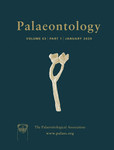Reg. Charity No. 1168330

The origin of amniotes was a key event in vertebrate evolution, enabling tetrapods to break their ties with water and invade terrestrial environments. Two pivotal clades of early tetrapods, the diadectomorphs and the seymouriamorphs, have played an unsurpassed role in debates about the ancestry of amniotes for over a century, but their skeletal morphology has provided conflicting evidence for their affinities. Using high‐resolution X‐ray microcomputed tomography, we reveal the three‐dimensional architecture of the well preserved endosseous labyrinth of the inner ear in representative species belonging to both groups. Data from the inner ear are coded in a new cladistic matrix of stem and primitive crown amniotes. Both maximum parsimony and Bayesian inference analyses retrieve seymouriamorphs as derived non‐crown amniotes and diadectomorphs as sister group to synapsids. If confirmed, this sister group relationship invites re‐examination of character polarity near the roots of the crown amniote radiation. Major changes in the endosseous labyrinth and adjacent braincase regions are mapped across the transition from non‐amniote to amniote tetrapods and include: a ventral shift of the cochlear recess relative to the vestibule and the semicircular canals; cochlear recess (primitively housed exclusively within the opisthotic) accommodated within both the prootic and the opisthotic; development of a distinct fossa subarcuata. The inner ear of seymouriamorphs foreshadows conditions of more derived groups, whereas that of diadectomorphs shows a mosaic of plesiomorphic and apomorphic traits, some of which are unambiguously amniote‐like, including a distinct and pyramid‐like cochlear recess.